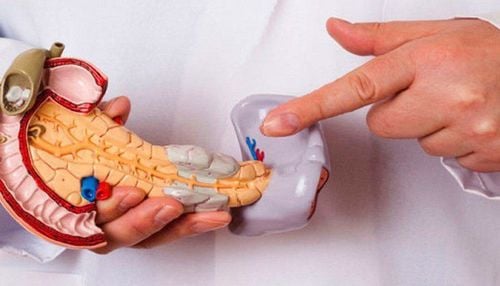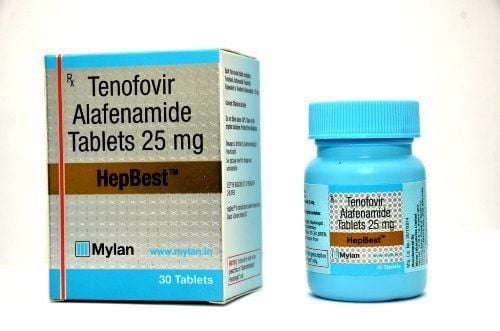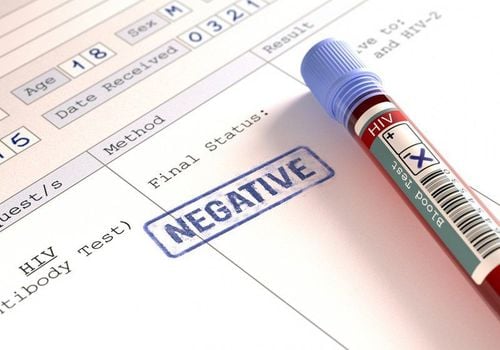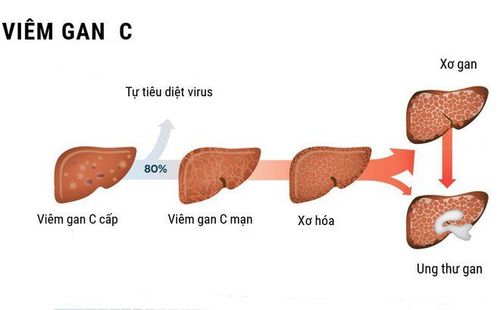This is an automatically translated article.
The genetic material of the hepatitis C virus is single-stranded RNA. Patients can be tested for hepatitis C for HCV RNA positive about 2 weeks after exposure to the virus, much earlier than testing for anti-HCV antibodies. Quantitative HCV RNA testing by PCR is highly sensitive and can help detect HCV virus even at very low blood levels.
1. What is HCV RNA?
Hepatitis C HCV RNA test is a type of molecular biological test to confirm whether a patient is infected with the hepatitis C virus. This test is performed by RT-PCR method.
A positive HCV RNA test means that the patient has been exposed to acute HCV virus for about 2-3 weeks. A positive HCV RNA test with a positive anti-HCV antibody test for more than 6 months indicates that the patient has progressed to chronic hepatitis C. In addition, the hepatitis C HCV RNA test is also indicated for the assessment and control of chronic HCV infection, prognosis, and monitoring the effectiveness of therapy in patients.
In this molecular biology test technique, the patient's plasma or serum sample is put into a specialized machine for RNA chain extraction. The HCV viral RNA will then undergo reverse transcription into a DNA strand, followed by amplification by PCR polymerization. With each amplification cycle, the signal reader in the PCR machine records a fluorescence signal from the probe that is specific to the genetic material of the hepatitis C virus. This fluorescence signal is used by the tester to Calculation of HCV virus concentration in patient samples.
In general, testing for HCV RNA has the following benefits:
Determination of the amount and concentration of HCV virus in the blood; Contributing to determining whether hepatitis C is acute or chronic; Monitor, predict and evaluate the response to treatment of each patient.
2. What are the indications for HCV RNA testing?
Hepatitis C virus RNA test is indicated in the following cases:
The patient has signs and symptoms of acute hepatitis C; The patient has factors suggesting, suspected exposure to hepatitis C virus; Anti-HCV antibody test positive; Indicated in the evaluation and monitoring of patients being treated for hepatitis C.

Giải đáp HCV RNA là gì?
3. Interpretation of hepatitis C HCV RNA test results
For qualitative HCV RNA test: If HCV is present in the patient's blood, this test will give a positive result. In contrast, the test is negative when the presence of the virus is not detected or the virus concentration in the blood is low. It is important to note that a qualitative viral RNA hepatitis C test result can still be positive even after the viral load has dropped drastically after treatment.
If the qualitative HCV RNA result is positive, the patient will be assigned a quantitative HCV RNA test. Therefore, at present, many specialists often skip the qualitative test and only determine the HCV RNA quantification at the initial time.
The quantitative HCV RNA test results show the hepatitis virus load in the patient's body. However, whether low or high, viral load does not reflect the extent of damage to the liver. In addition, quantitative testing of the patient's HCV virus before treatment will help doctors monitor the patient's viral load during and after treatment.
After the HCV RNA test results are available and the presence of HCV is confirmed, the doctors order the test to find out exactly which strain of the hepatitis C virus the patient is infected with. This helps the doctor plan a specific course of treatment.
Some other notes:
The goal of treatment is to reduce the HCV viral load until the viral load is below the detectable threshold, this is referred to as the SVR; SVR occurs when viral load is below the detectable threshold for 12 weeks or longer depending on the patient's treatment regimen; Achieving an effective SVR means that the patient no longer has hepatitis C or the treatment has cured hepatitis C; However, some cases, despite achieving SVR, are still capable of re-infection with other strains of hepatitis C virus. Therefore, patients must change their lifestyle to prevent HCV infection, including not injecting drugs, ensuring safe sex, not tattooing, piercing ears... See more: 5 reasons you should get tested for hepatitis C
4. What does HCV RNA test mean?
4.1. Diagnosis of acute hepatitis C
After 2 weeks from the time of exposure to the virus, the hepatitis C HCV RNA test may give a positive result, at this time the body has not yet produced anti-HCV antibodies (appears after 5-10 weeks). ). Therefore, the patient will be diagnosed with acute hepatitis C when HCV RNA is positive and anti-HCV is negative.
4.2. Identify chronic hepatitis C
The probability of progression to chronic hepatitis of HCV virus is highest when compared with other hepatitis viruses. Up to 80% of cases will progress to chronic hepatitis C. At this point, the patient's hepatitis C test results will include positive HCV RNA and positive anti-HCV as well. For these cases, testing for HCV RNA may be an alternative to testing for hepatitis C virus core antigen (HCV core-Ag).
4.3. Diagnosis of hepatitis C in children
For children under 18 months of age, the diagnosis of HCV infection is achieved when at least 2 positive HCV RNA tests are performed. The time to test for hepatitis C includes when the baby is 6 months and 12 months old.
For children over 18 months of age, HCV infection is only diagnosed when HCV RNA is positive and anti-HCV is positive.

Xét nghiệm viêm gan C tìm RNA của virus được chỉ định khi người bệnh có triệu chứng của viêm gan C cấp tính
4.4. Significance of hepatitis C HCV RNA test in treatment
Indications for treatment:
The patient will be prescribed a hepatitis C treatment regimen when the HCV RNA test is positive and anti-HCV is positive; Before starting treatment, patients should be monitored for HCV RNA testing for at least 12 weeks from the time of first diagnosis. This is to determine the body's natural ability to clear the virus, if the HCV RNA test is still positive after 12 weeks of follow-up, then treatment will be started. Follow-up after treatment: The patient will be recognized for treatment of hepatitis C when the sustained virological response threshold is achieved. At that time, the HCV RNA load must be below the detection threshold (<15 IU/ml) at the 12th week after the end of treatment, called SVR 12. Particularly in case of using Peginterferon-containing regimen, the HCV load is RNA must be below the detection threshold at 24 weeks after the end of treatment, called SVR 24.
Indication to change treatment regimen: At 4 weeks of treatment, if inflammatory test results HCV RNA quantification above threshold should be retested at week 8. If HCV RNA load increases more than 10 times, discontinue current regimen and replace with another regimen.
5. Some factors affect hepatitis C . test results
Some factors to keep in mind, including:
Hepatitis C virus RNA is unstable genetic material, easily degraded. Therefore, testing for hepatitis C for HCV RNA should be performed as soon as possible after sampling; The HCV RNA test sample can be plasma or serum, however clot formation can reduce the viral load. Therefore, the use of EDTA tubes is recommended to perform the test; Do not use Heparin anticoagulant tubes due to the possibility of inhibiting PCR reactions. If hepatitis C is detected early, prompt treatment can return a healthy liver to the patient. Therefore, the process of taking samples, preserving and transporting samples for hepatitis C testing must ensure the following requirements:
Sampling: Take about 2ml of whole blood, then put it into an EDTA tube or a Serum tube; Storage and transportation: Preserve samples at room temperature from 18-25 degrees Celsius, the maximum time is 24 hours, they must be transported to the laboratory. Sometimes samples can be stored in a refrigerator, at a temperature of 2-8 degrees Celsius and transported to the laboratory within 2 days. In case of force majeure that cannot be transported in accordance with regulations, sample collection staff can separate plasma or serum and store it at -20 degrees Celsius until transportation. Hepatitis C HCV RNA test is a type of molecular biological test to confirm whether a person is infected with the hepatitis C virus. This test is performed by RT-PCR method. To ensure accurate results, for medical examination and treatment, you should go to reputable medical centers to perform.
Please dial HOTLINE for more information or register for an appointment HERE. Download MyVinmec app to make appointments faster and to manage your bookings easily.













